Small space gardening is a great way to make your outdoor area look lush and vibrant. It’s perfect for balconies and patios with limited space. You can turn your small space into a beautiful and useful outdoor area with the right ideas.
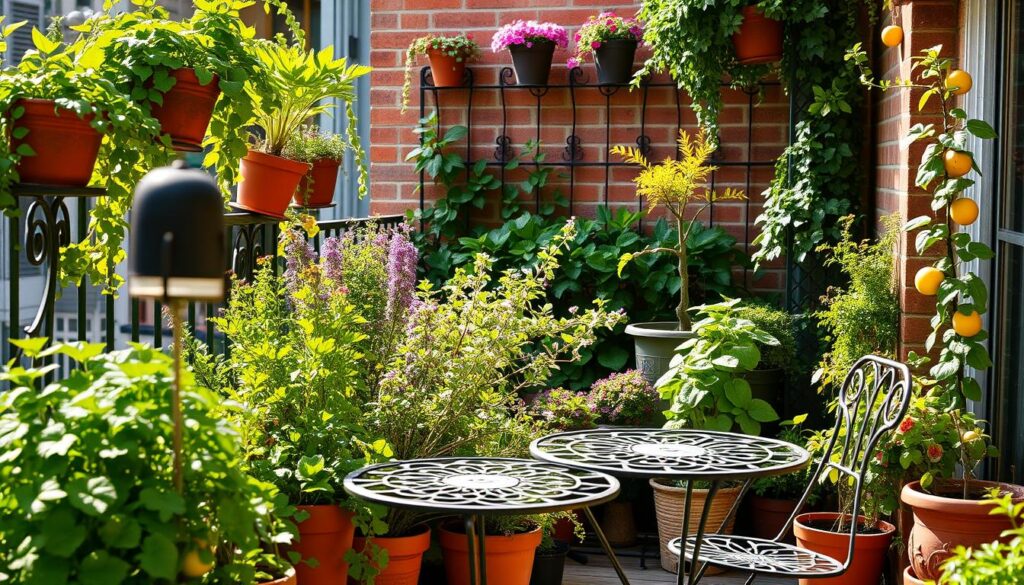
Even if you have a tiny balcony or patio, you can still enjoy gardening. It’s all about using your space wisely. With the right tools and techniques, you can grow a lot in a small area. There are many ways to start small space gardening, from balconies to patios.
Introduction to Small Space Gardening
Small space gardening adds greenery to your outdoor area. It also purifies the air and makes your home look better. You can grow your own herbs, veggies, and flowers. It’s a great way to start gardening, whether you’re new or experienced.
Key Takeaways
- Small space gardening is perfect for urban dwellers with limited outdoor space
- Balcony gardening and patio gardening offer a lot of possibilities for small space gardening
- Small space gardening can help to purify the air and improve the aesthetic of your home
- You can grow your own herbs, vegetables, and flowers with small space gardening
- Small space gardening is a great way to get started with gardening, even with limited experience
- Small space gardening ideas can help you transform your outdoor space into a beautiful and functional area
Understanding Your Small Space Garden Potential
Small space gardening is all about making the most of what you have. You need to look at the space, sunlight, weight limits, and climate. By doing this, you can create a garden that grows well in your area. There are many tips and ideas to help you garden in small spaces.
First, measure your space. Think about the size and shape of your balcony, patio, or yard. Also, consider how much sunlight your garden gets. This will help you pick the right plants.
If your garden gets a lot of sun, choose plants that love it. For shaded areas, pick plants that do well in the shade.
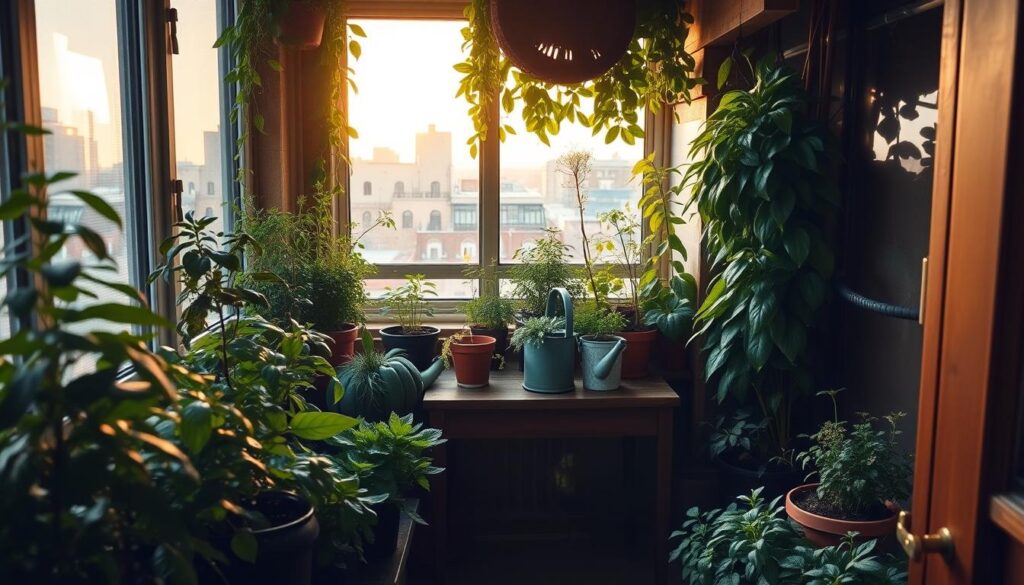
Then, think about the weight your garden can handle. If you’re gardening on a balcony or patio, check the weight limit. This is key in small space gardening, where every bit of space matters.
Use lightweight planters or try vertical gardening to stay within the weight limit. This way, you can still have a beautiful garden.
Assessing Available Space and Sunlight
- Measure the length, width, and height of your garden
- Determine the amount of sunlight your garden receives each day
- Choose plants that thrive in your garden’s conditions
Evaluating Weight Restrictions
Check the weight limit of your balcony or patio
Determining Climate Considerations
Research the climate in your area to determine which plants will thrive
Essential Tools and Materials for Small Space Gardening
For container gardening, the right tools and materials are key. In small spaces, choose containers that save space and grow well. Options include vertical planters, hanging baskets, and wall-mounted planters.
Choosing the right soil and fertilizers is vital for space-saving gardening. Look for compact, nutrient-rich potting mixes for small gardens. Also, use trellises or supports to help plants grow upwards, making the most of your space.
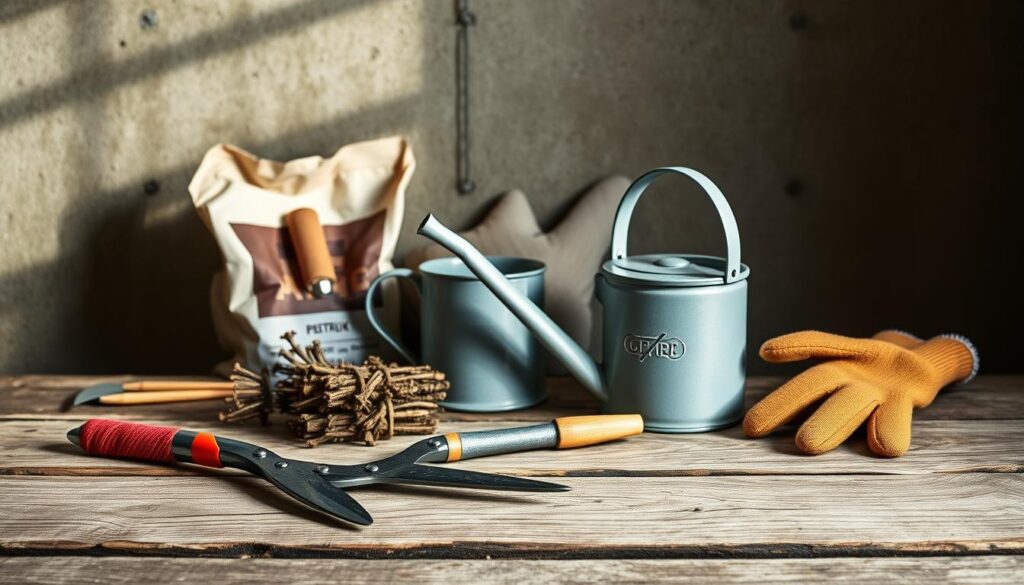
- Watering can or gentle hose nozzle
- Pruning shears or clippers
- Soil test kit
- Fertilizer or compost
Investing in these tools and materials will help you create a thriving small space garden. It will follow the principles of container gardening and space-saving gardening. With creativity and planning, even the smallest area can become a beautiful garden oasis.
| Tool | Description |
|---|---|
| Watering can | For gentle, targeted watering |
| Pruning shears | For trimming and shaping plants |
| Soil test kit | For monitoring soil pH and nutrient levels |
Selecting the Perfect Containers and Planters
Choosing the right containers and planters is key for small space gardening. This is especially true for urban gardening, where space is tight. The right containers help you make the most of your space, creating a thriving garden in even the smallest areas.
Vertical gardening is a great option for small spaces. It uses containers or planters mounted on walls or trellises. This way, you can add greenery to your balcony or patio without using much floor space.
Container Options
- Self-watering containers: These containers have a built-in water reservoir. This lets plants draw water as needed, reducing watering frequency.
- Space-saving pot arrangements: These use multiple small pots or planters to create a larger display. They don’t take up much space.
- Vertical planters: These are designed for mounting on walls or trellises. They let you add greenery without using much floor space.
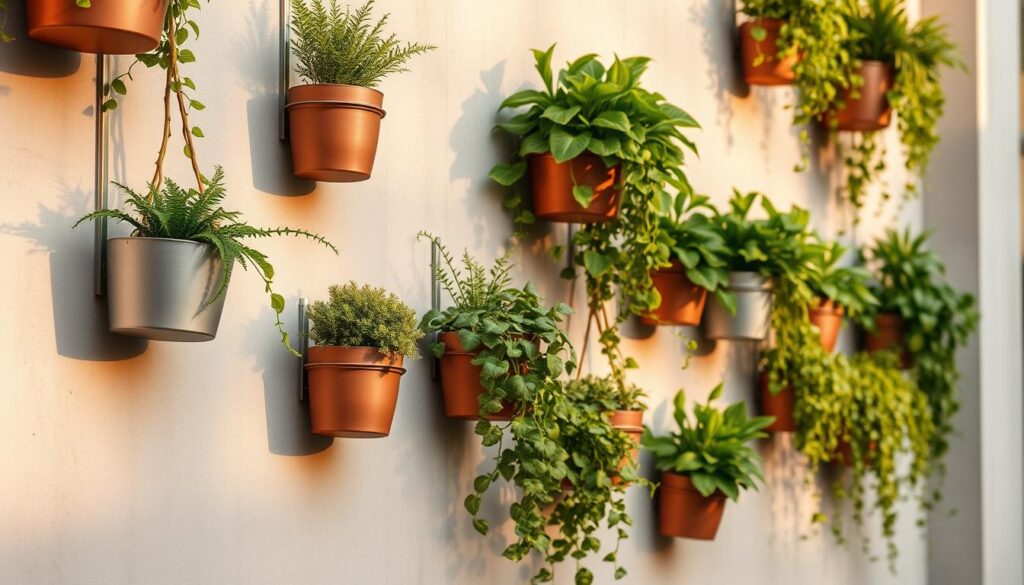
By picking the right containers and planters, you can create a beautiful garden in small spaces. Whether you’re into vertical gardening or urban gardening, there are many options to help you start.
| Container Type | Benefits |
|---|---|
| Self-watering containers | Reduced watering frequency, increased plant health |
| Space-saving pot arrangements | Maximized space, increased visual appeal |
| Vertical planters | Increased space efficiency, added greenery |
Small Space Gardening Ideas for Balconies & Patios: Design Principles
Design principles are key in small space gardening. They help create a beautiful and useful garden, whether on a balcony or patio. It’s important to think about the look and needs of your plants and space. Balcony gardening and patio gardening need careful planning to use space well and grow a healthy garden.
To start, focus on these important elements:
- Lighting: Make sure your plants get the right sunlight and shade.
- Watering: Pick plants that do well in your area and think about using containers that water themselves.
- Space: Use vertical gardening and clever pot arrangements to save space.
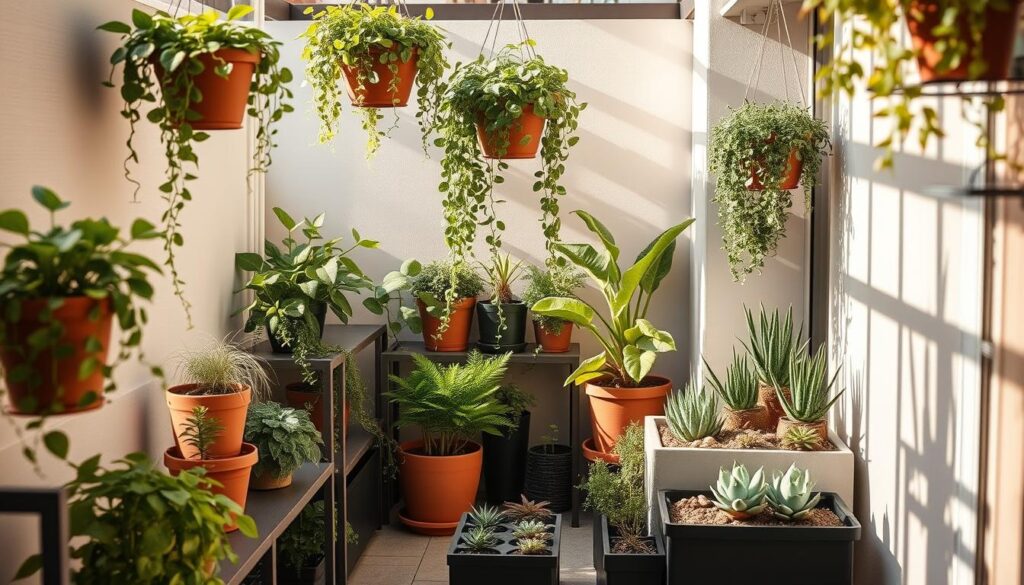
By using these design tips, you can make a small space garden that looks good and works well. Choose plants that fit your climate and space. Don’t hesitate to try new layouts and designs. With creativity and planning, you can make your balcony or patio a lush small space garden haven.
| Design Principle | Description |
|---|---|
| Balance | Achieve a balance between plants, containers, and decorative elements. |
| Harmony | Choose plants and materials that complement each other in terms of color, texture, and shape. |
| Functionality | Consider the purpose of your garden and design it to meet your needs. |
Choosing the Right Plants for Limited Spaces
Choosing the right plants is key for a small space garden. With some planning and creativity, you can make a beautiful garden in even the smallest areas. Use space-saving gardening and DIY gardening ideas to maximize your space.
Compact vegetables and herbs like cherry tomatoes, lettuce, and basil are great for small gardens. They need little space and do well in containers or vertical gardens. For color, add flowers like petunias or geraniums. They add beauty without taking up much room.
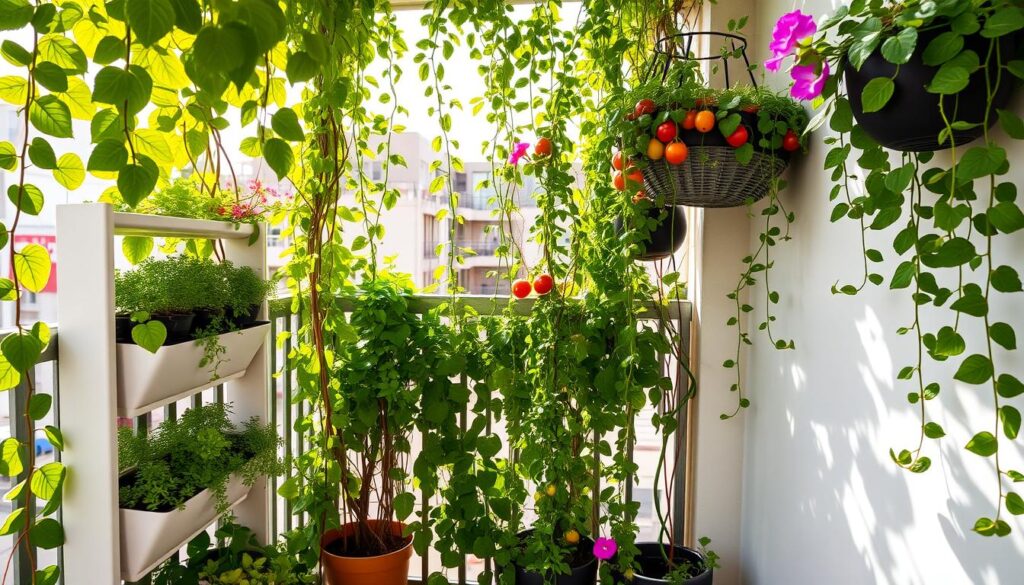
Dwarf varieties of plants, like dwarf citrus trees or compact shrubs, are also good for small gardens. These plants are bred to be smaller, perfect for space-saving gardening and DIY gardening. By picking the right plants, you can enjoy a beautiful outdoor space all year.
Using compact plants in small gardens has many benefits. They include:
- Increased yields in smaller spaces
- Improved air circulation and reduced disease risk
- Enhanced visual appeal and beauty
Vertical Gardening Techniques and Solutions
Vertical gardening is a smart way to use space in cities. It lets you grow many plants in a small area. You can use walls, trellises, or supports to make plants grow up.
This method is perfect for small spaces like balconies or patios. It’s great for adding greenery to urban areas. This can help clean the air and make the area look better.
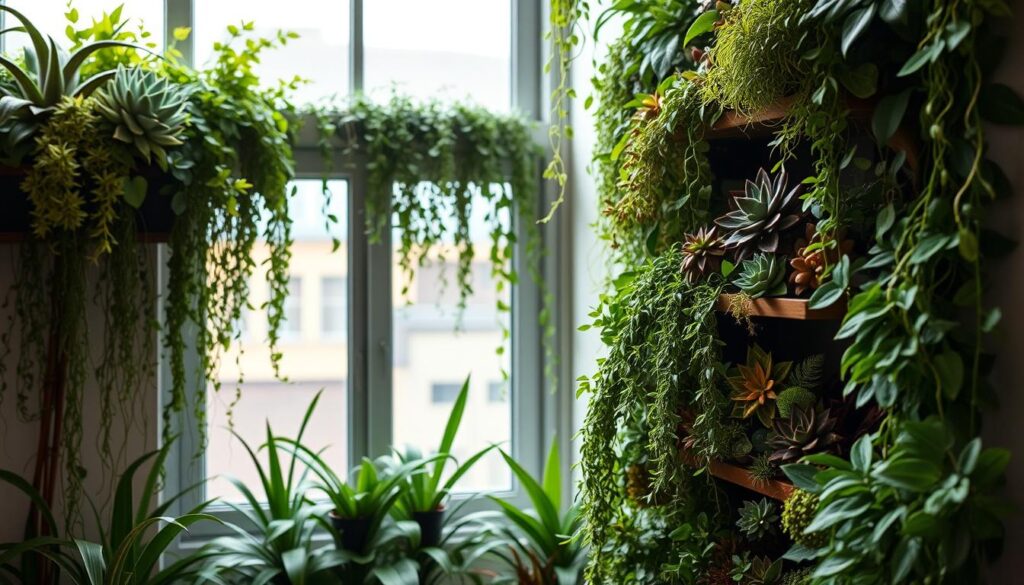
Vertical gardening can be simple or complex. You can start with container gardening to try different designs. Plants like succulents, herbs, and vines work well for this.
When gardening vertically, pick plants that fit the light and water they’ll get. Use strong supports for the plants and soil. A self-watering system can also help with care.
| Plant Type | Light Requirements | Water Requirements |
|---|---|---|
| Succulents | Full sun to partial shade | Infrequent watering |
| Herbs | Partial shade to full sun | Regular watering |
| Flowering Vines | Full sun to partial shade | Regular watering |
Follow these tips and use the right materials for a beautiful vertical garden. It’s perfect for small spaces in cities and container gardening.
Smart Watering Systems for Small Gardens
Smart watering systems are key for small gardens. They save water and cut down on waste. Using drip irrigation is a smart move. It sends water straight to the roots, cutting down on evaporation and runoff.
For small gardens, consider using rain barrels and grey water systems. These methods save a lot of water. On balconies, pick plants that don’t need much water.
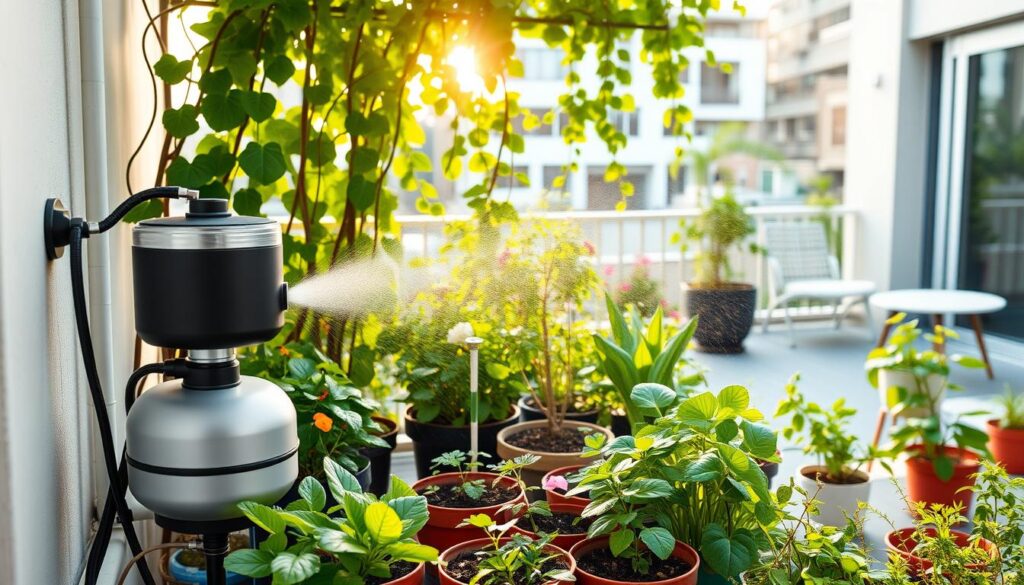
- Use mulch to keep soil moist
- Install a rain sensor to stop watering when it rains
- Set a drip irrigation timer for regular watering
| Watering Method | Water Savings |
|---|---|
| Drip Irrigation | 20-30% |
| Rain Barrels | 30-50% |
| Grey Water Systems | 40-60% |
By using these smart watering systems, gardeners can make their small gardens beautiful and green.
Maximizing Growing Space with Multi-Level Arrangements
Urban gardeners often face the challenge of limited space. But, with a bit of creativity, you can make the most of your space. This is especially true for patio gardening, where space is usually tight.
Using tiered planters is a great way to stack plants on top of each other. This saves space and makes your garden look good. You can also use shelving units to display plants and gardening tools.
Some benefits of multi-level arrangements include:
- Increased growing space
- Improved air circulation
- Enhanced visual appeal
You can mix urban gardening containers with trellises for a multi-level setup. This is perfect for climbing plants like ivy or clematis. They can grow up the trellis.
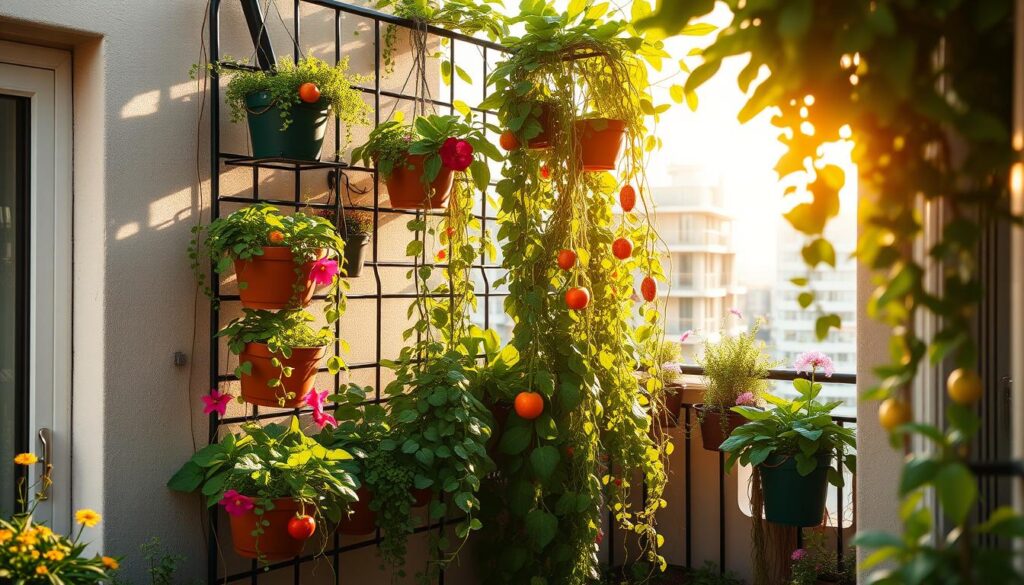
By using multi-level arrangements, you can make a small space into a thriving garden. This technique is great for both experienced and new gardeners. It encourages you to think outside the box when designing your garden.
| Multi-Level Arrangement | Benefits |
|---|---|
| Tiered Planters | Space-saving, visually appealing |
| Shelving Units | Increased storage, improved air circulation |
| Trellises | Support for climbing plants, enhanced visual appeal |
Year-Round Maintenance Tips for Small Gardens
To keep your small garden thriving, follow a few simple maintenance tips. DIY gardening is fun and rewarding but needs planning and attention. Container and vertical gardening make the most of space but need regular watering and fertilizing.
Seasonal plant care is key. Different plants need different things at different times. Research your plants’ needs for pruning, repotting, and weather protection. This helps your plants stay healthy and thrive, even in small spaces like balconies or patios.
Seasonal Plant Care
- Spring: Plant new flowers and vegetables, and fertilize existing ones
- Summer: Water regularly and provide shade for plants that need it
- Autumn: Harvest crops and prepare soil for winter
- Winter: Protect plants from frost and provide extra care for sensitive species
Pest management is also crucial in small gardens. Use natural methods like neem oil or introduce beneficial insects to control pests. A proactive approach to pest management keeps your plants healthy. With planning and attention, enjoy a thriving and beautiful small garden all year, using DIY, container, and vertical gardening.
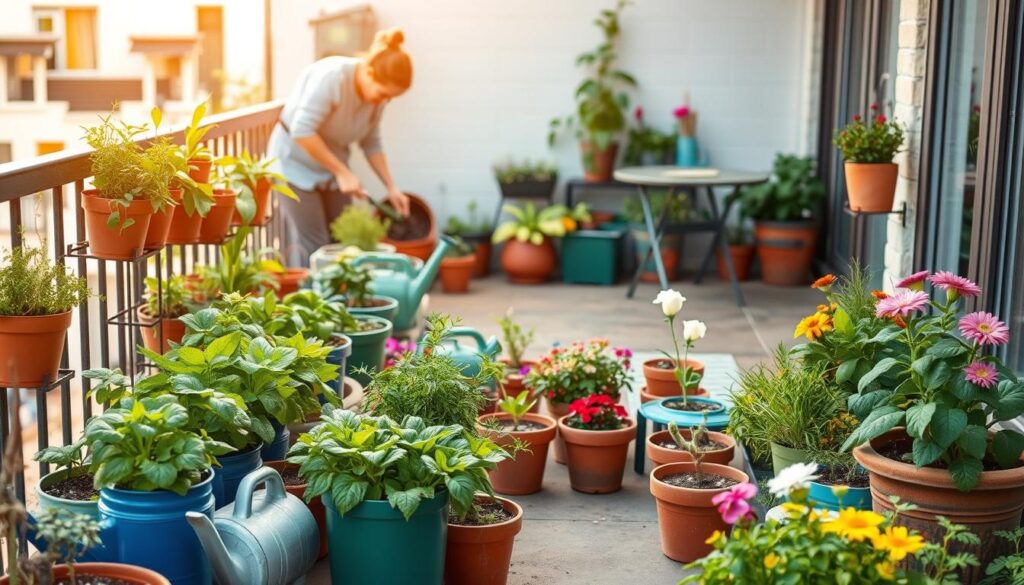
Fertilizing Schedule
A fertilizing schedule helps track when to feed your plants. This is especially important in small gardens where soil nutrients may be limited. Regular fertilizing keeps your plants healthy and thriving, even in small spaces.
| Month | Fertilizer Type | Application Rate |
|---|---|---|
| March | Balanced fertilizer | 1 tablespoon per gallon |
| June | High-phosphorus fertilizer | 2 tablespoons per gallon |
| September | Low-nitrogen fertilizer | 1 teaspoon per gallon |
Creating Privacy and Shade with Plants
In small space gardening, privacy and shade are key for a cozy outdoor area. Plants can act as a natural screen, perfect for urban gardens where space is tight. They help create a snug and private spot in your garden.
Popular plants for privacy and shade include bamboo, arborvitae, and boxwood. These are great for small spaces because they’re compact and low-maintenance. Here’s why plants are good for privacy and shade:
- Natural screen: Plants block out unwanted views, giving you privacy.
- Shade: Dense foliage plants offer shade, cutting down on the need for umbrellas.
- Aesthetic appeal: Plants add beauty and texture, making your garden look great.
When picking plants, think about your garden’s needs. Choose plants that fit your climate, soil, and sunlight. With the right plants, even the smallest spaces can become a private and shaded oasis.
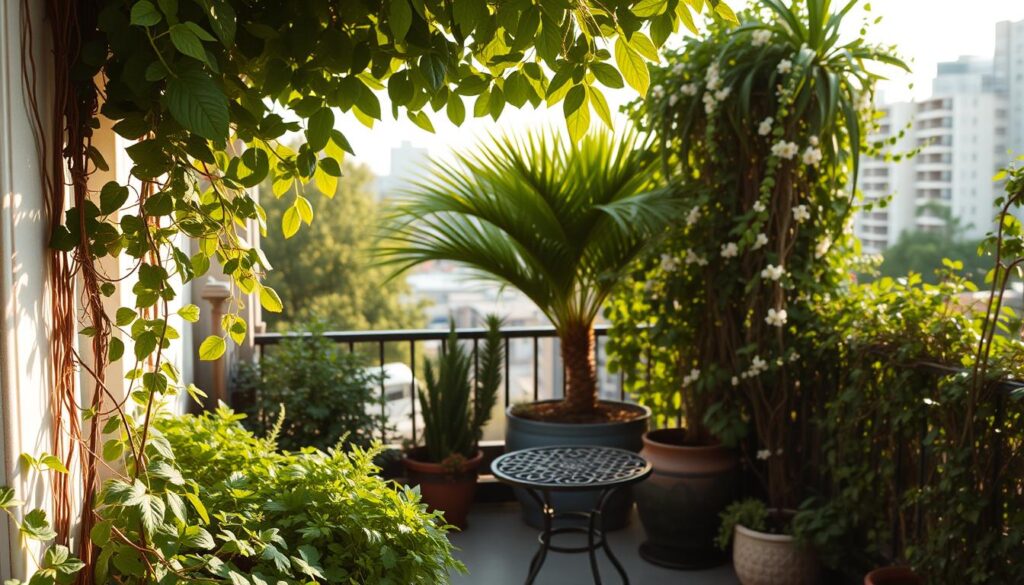
Using plants for privacy and shade can make your small space garden a peaceful escape. It’s perfect for a quiet reading spot or a cozy dining area. Plants help you make the most of your space in small space and urban gardening, offering great ideas for your garden.
Conclusion: Transforming Your Small Space into a Thriving Garden Oasis
This guide has shown you how to make your balcony or patio garden come alive. By picking the right plants and using vertical gardening, even tiny spaces can become green havens. Smart watering systems also play a big role in keeping your garden healthy.
Success in small space gardening starts with knowing your space, sunlight, and weight limits. With creativity and the right strategy, you can create a lush garden. It will bring joy and peace to your outdoor area. So, get creative, try new things, and watch your garden grow.
FAQ
What are the key factors to consider when assessing my small space garden potential?
When looking at your small space garden, think about the space you have. Also, consider the sunlight, weight limits, and your local climate. These factors will help you make a garden that does well in your area.
What are the essential tools and materials needed for small space gardening?
For small space gardening, you’ll need containers, soil, and fertilizers. You’ll also want to use space-saving tricks like trellises and wall-mounted planters.
What are some effective vertical gardening solutions for small spaces?
Vertical gardening is great for small spaces. Use hanging baskets, wall-mounted planters, and tiered setups to make the most of your space.
How can I choose the right plants for my limited garden space?
For your small garden, pick compact veggies and herbs. Also, choose space-saving flowers and dwarf versions of popular plants. This way, you won’t overcrowd your space.
What are some smart watering systems I can use to conserve water in my small garden?
Smart watering for small gardens includes drip irrigation and water-saving methods. You can also use rainwater collection systems to cut down on waste and keep your garden healthy.
How can I create privacy and shade in my small garden?
To add privacy and shade, place plants that act as natural screens. These plants will also provide shade for your outdoor area.